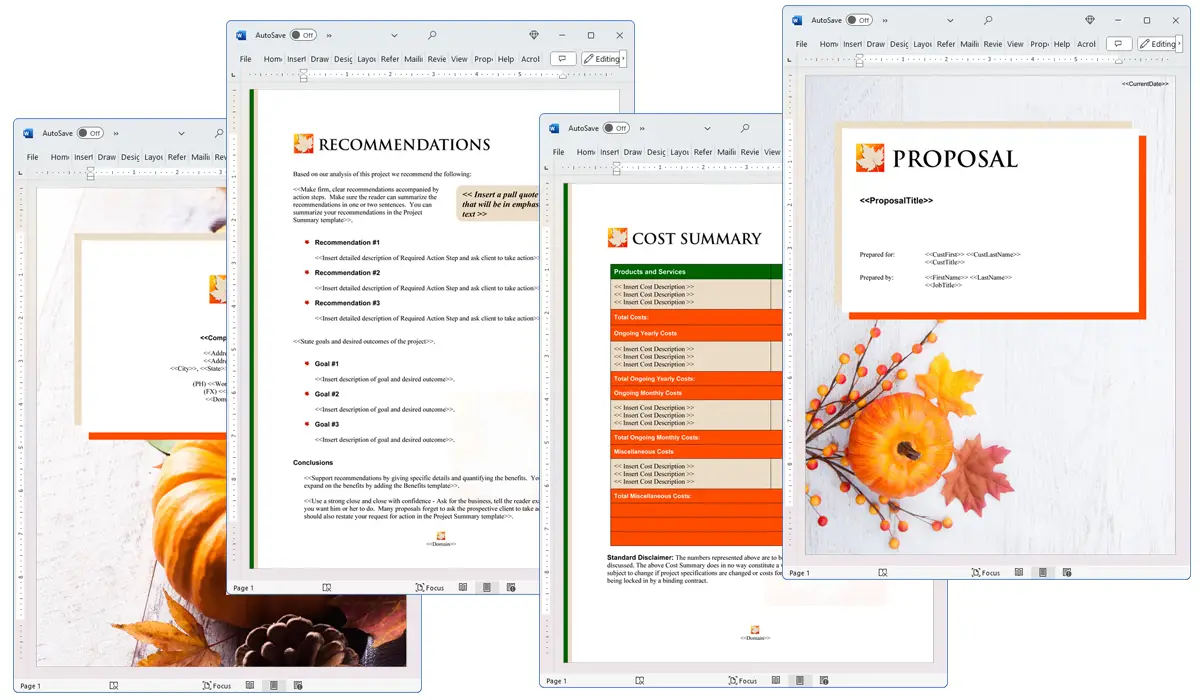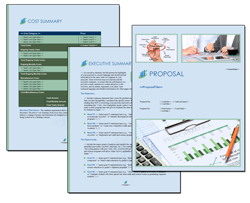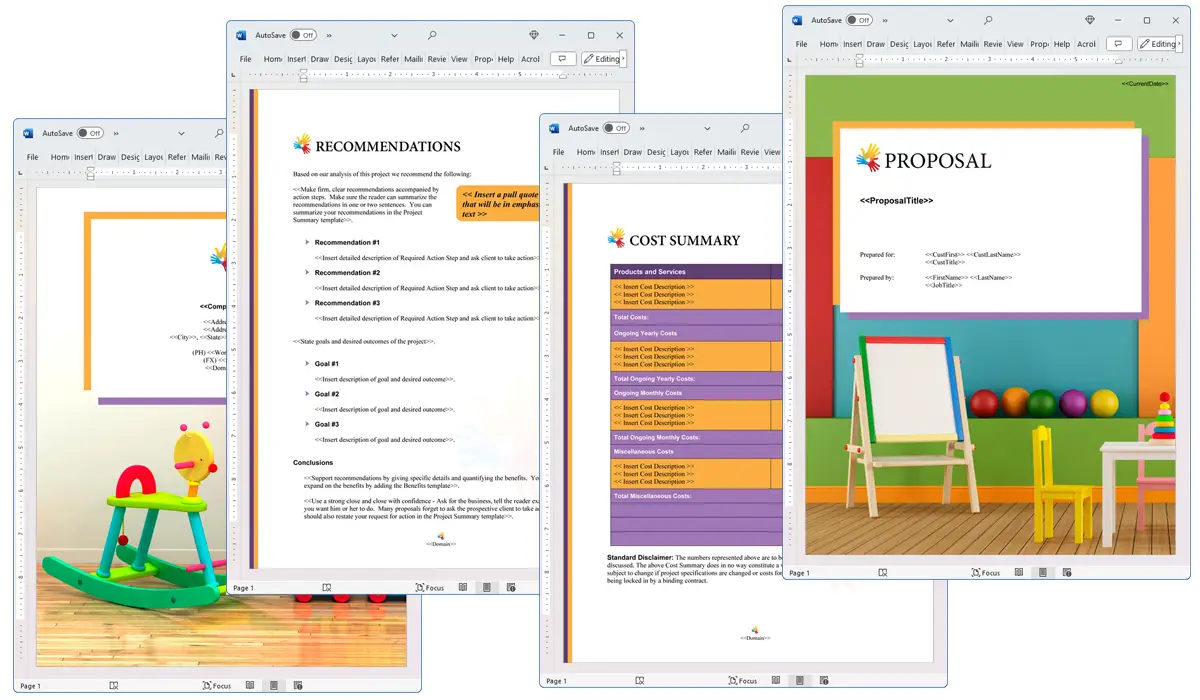What is the Cargo chapter used for?
Proposal Kit Professional Bundle adds more design themes, all six Contract Packs,
a project management library, and Expert Edition software.

Illustration of Proposal Pack Seasonal #4
We include this Cargo chapter template in every Proposal Pack, along with thousands more. You assemble this chapter with others in various combinations to create custom-tailored business proposals, plans, reports, and other documents. Proposal Packs apply custom visual designs to the templates, giving the final documents a consistent professional finish.
 DOWNLOADABLE, ONE-TIME COST, NO SUBSCRIPTION FEES
DOWNLOADABLE, ONE-TIME COST, NO SUBSCRIPTION FEES
Overview of the Cargo Chapter
The Cargo chapter is an important part of the Proposal Kit system, designed to streamline and enhance the clarity of proposals involving transportation, shipping, or hauling services. This chapter helps businesses clearly outline the specifics of the cargo involved in their proposal, ensuring that all parties have a detailed understanding of the logistics and requirements. By providing comprehensive information about the cargo, this chapter aids in creating a more persuasive and effective proposal.
How is the Cargo Chapter Used?
The Cargo chapter is typically used in business proposals that require a detailed description of items or goods being transported. This could include proposals submitted by freight companies, logistics service providers, or businesses that need to outline shipping needs for project components. The chapter serves as a structured way to present vital information about the cargo, which could influence decision-making or the planning of the logistics involved in a project.
What is Included in the Cargo Chapter?
In the Cargo chapter, several key elements are typically included to ensure that the cargo is described thoroughly:
- Size and Dimensions: Details about the size of the cargo, which might affect the choice of transportation.
- Quantity: Information on the number of units or the volume of the cargo.
- Special Conditions Required: Any specific conditions needed to safely and transport the cargo, such as temperature control or handling requirements.
- Labeling or Warning Requirements: Necessary labels or warnings that must accompany the cargo, important for regulatory compliance and safety.
- Route Considerations: Potential issues or special considerations regarding the transportation route that might impact delivery.
- Special Vehicles Needed: Information on any special vehicles or equipment required to transport the cargo, which affects logistics planning and cost.
Use Case Examples for the Cargo Chapter
- Service Sales: A logistics company outlines the specifics of transporting sensitive electronic equipment for a client, detailing the protective measures and special handling required.
- Physical Items: A manufacturer details the shipment of bulky machinery to an overseas facility, including size, weight, and special vehicle requirements for safe delivery.
- Project Materials: A construction firm proposes the delivery of building materials, specifying quantity, route considerations to the remote site, and special conditions like moisture-proof packaging.
- Hazardous Materials: A chemical producer describes the necessary safety warnings and handling instructions for transporting hazardous materials, ensuring compliance with regulations.
- Event Planning: An event planner specifies the transportation of stage equipment and props, including size dimensions for proper vehicle allocation.
Key Takeaways
- The Cargo chapter is vital for proposals involving the transportation of goods, ensuring all cargo details are clear and comprehensive.
- It helps businesses communicate crucial logistics and requirements that affect the transportation of items.
- Key information such as size, special conditions, and route considerations are detailed to aid in planning and decision-making.
- The chapter is and can be used across various industries, including manufacturing, construction, and event planning.
- Proper use of the Cargo chapter enhances the professionalism and effectiveness of business proposals, leading to better project outcomes and client satisfaction.

Illustration of Proposal Pack Financial #4
 What Our Clients Say
What Our Clients SayWell put together and easy to use material with great tutorials. Thanks for all the help setting it up."
Talk Thru Facilitation
 4.7 stars, based on 845 reviews
4.7 stars, based on 845 reviewsRelated Chapters

The Cargo chapter and other chapters are integrated into a Word document as illustrated here in the Proposal Pack Children #4 design theme. There are hundreds of design themes available, and every design theme includes the Cargo chapter template.
A proper business proposal will include multiple chapters. This chapter is just one of many you can build into your proposal. We include the complete fill-in-the-blank template in our Proposal Pack template collections. We also include a library of sample proposals illustrating how companies in different industries, both large and small, have written proposals using our Proposal Packs. This template will show you how to write the Cargo.
We include a chapter library for you to build from based on your needs. All proposals are different and have different needs and goals. Pick the chapters from our collection and organize them as needed for your proposal.
Using the Proposal Pack template library, you can create any business proposal, report, study, plan, or document.
 Ian Lauder has been helping businesses write their proposals and contracts for two decades. Ian is the owner and founder of Proposal Kit, one of the original sources of business proposal and contract software products started in 1997.
Ian Lauder has been helping businesses write their proposals and contracts for two decades. Ian is the owner and founder of Proposal Kit, one of the original sources of business proposal and contract software products started in 1997.By Ian Lauder
 Published by Proposal Kit, Inc.
Published by Proposal Kit, Inc.


 Cart
Cart
 Facebook
Facebook YouTube
YouTube X
X Search Site
Search Site